During the first five days of its mission, the Apollo 9 crew of Commander James A. McDivitt, Command Module Pilot David R. Scott, and Lunar Module Pilot Russell L. Schweickart was extremely busy. Mission planners had designed the flight so the most important objective of the 10-day mission, the first in-orbit crewed test of the Lunar Module (LM), could be accomplished even if for whatever reason the flight had to be cut short. Once that goal was successfully met and the LM was jettisoned, the pace of activities slowed somewhat starting on Flight Day (FD) 6. Recalling the busy first few days, McDivitt called down to thank the Mission Control team for all its great work, summarizing with, “We’ve got the world’s greatest set of controllers.” He added jokingly about the overall performance of the team and the space vehicles, “Might give you the impression that it might work, huh?” The crew sang a belated “Happy Birthday” to Christopher C. Kraft, Jr., Director of Flight Operations at the Manned Spacecraft Center (MSC), now the Johnson Space Center in Houston, whose birthday on Feb. 28 was the original Apollo 9 launch date, and later another belated “Happy Birthday” to Charlotte A. Maltese, the Apollo 9 crew secretary.
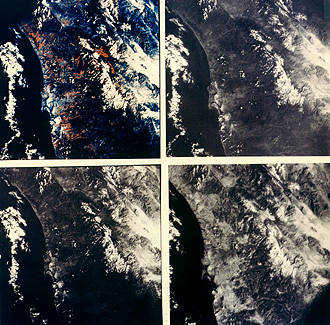
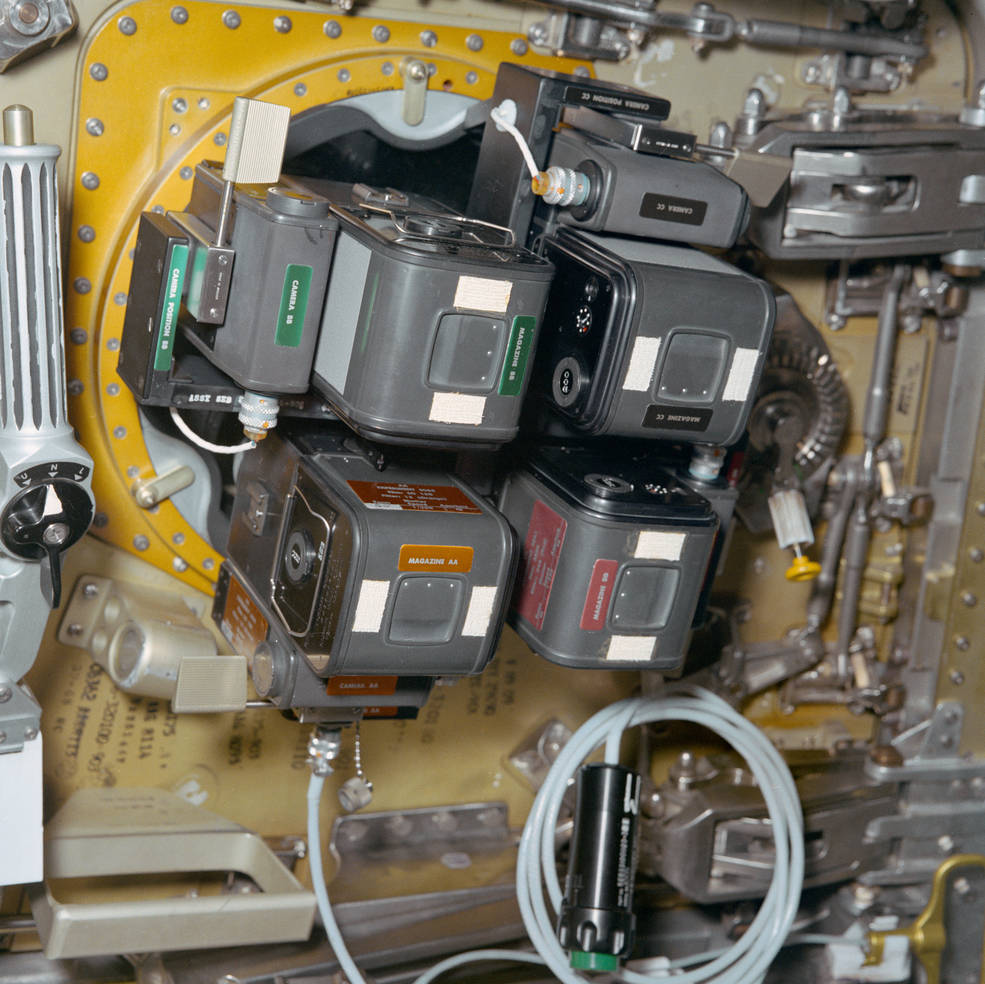
Left: Experiment S065 multispectral image of the San Diego area, including parts of California and
Mexico – upper left: false color infrared; upper right: green filter; lower left: red filter; lower right: black
and white infrared. Right: Experiment S065 camera system installed in the CM hatch window.
The first major spacecraft system task of FD6 was the sixth firing of the Service Propulsion System (SPS) engine. This brief one and a half second burn lowered the low point of Gumdrop’s orbit, to enhance a backup capability to use the Reaction Control System (RCS) thrusters for the deorbit burn at the end of the mission, should a problem arise with the SPS. Shortly after this burn, the crew set up the one formal scientific investigation of their mission – Experiment S065 Multispectral Terrain Photography, a cluster of four Hasselblad 70 mm cameras pointed out the Command Module’s (CM) round hatch window. The experiment provided photographs taken simultaneously in four specific portions of the visible and near infrared spectrum. One of the major objectives was to see whether this type of photography can be effectively applied to earth resources programs such as agriculture, forestry, geology, oceanography, hydrology, and geography. The experiment served as a precursor for the Earth Resources Technology Satellite (ERTS), later renamed Landsat, and for multispectral photography conducted aboard the Skylab space station in the early 1970s. During the first pass of the experiment, photographs were taken from the coast of California to El Paso, Texas, and a shorter series over Houston.
Over the next four days, the astronauts continued observations with the S065 camera system, making passes over the southern United States, parts of Mexico, the Atlantic Caribbean and the Cape Verde Islands. By the end of the mission, they exposed 127 complete four-frame sets with the experiment. Following postflight analysis of the images, Edward Yost of Long Island University, co-investigator for the experiment, summarized the outcome, “From a scientific standpoint, the results have been impressive.” The crew also took 1,100 Earth observation photographs of targets around the world, using color and color infrared film and a handheld Hasselblad camera.
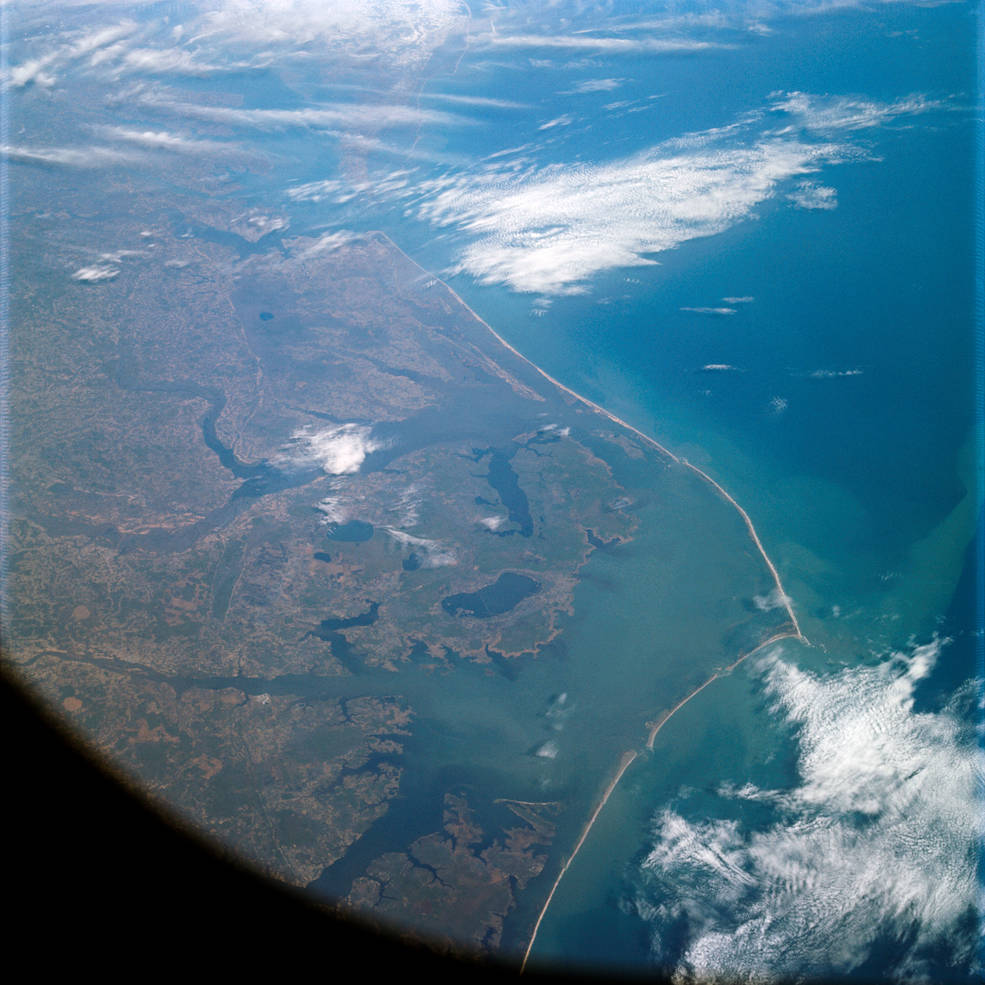
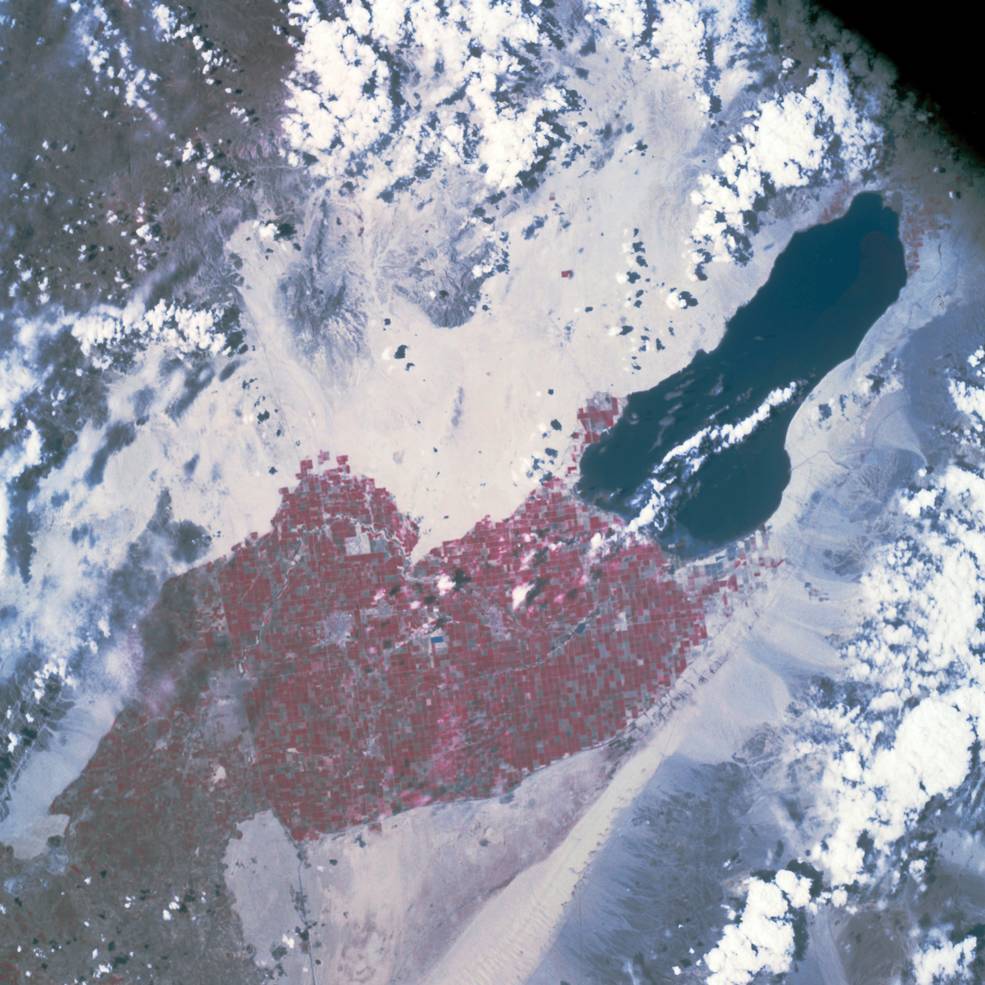
Handheld Earth observation photographs taken by the Apollo 9 crew. Left: The coast of
North Carolina. Right: Color infrared photograph of the
Salton Sea in California.
On FD 8, the crew completed the seventh SPS burn, a 25-second firing to establish the proper trajectory for the deorbit burn and also optimize an RCS capability for one revolution after the nominal deorbit. The next day, the astronauts made observations using their spacecraft’s optical device of the large Pegasus 3 satellite, in orbit since July 30, 1965, as it passed within 1,000 miles and 700 miles of Apollo 9 during two successive orbits. They also observed the LM ascent stage from about 700 miles away. On FD 10, Mission Control decided to delay their splashdown the next day by one revolution, due to expected inclement weather at the planned time.
On Mar. 13, 1969, after 151 revolutions around the Earth and while passing over Hawaii, the crew fired the SPS engine for the eighth and final time. Lasting just under 12 seconds, the burn brought Apollo 9 out of orbit. The CM Gumdrop separated from its Service Module and pointed its heat shield in the direction of flight. During reentry, the heat shield reached a maximum of 2,700 degrees F, but inside the capsule the crew remained at room temperature. A sheath of ionized gas formed around the capsule by the rapid deceleration led to a 4-minute radio blackout, after which the drogue parachutes deployed. The three main parachutes opened at 10,000 feet altitude, slowing the spacecraft to about 22 miles per hour at splashdown.
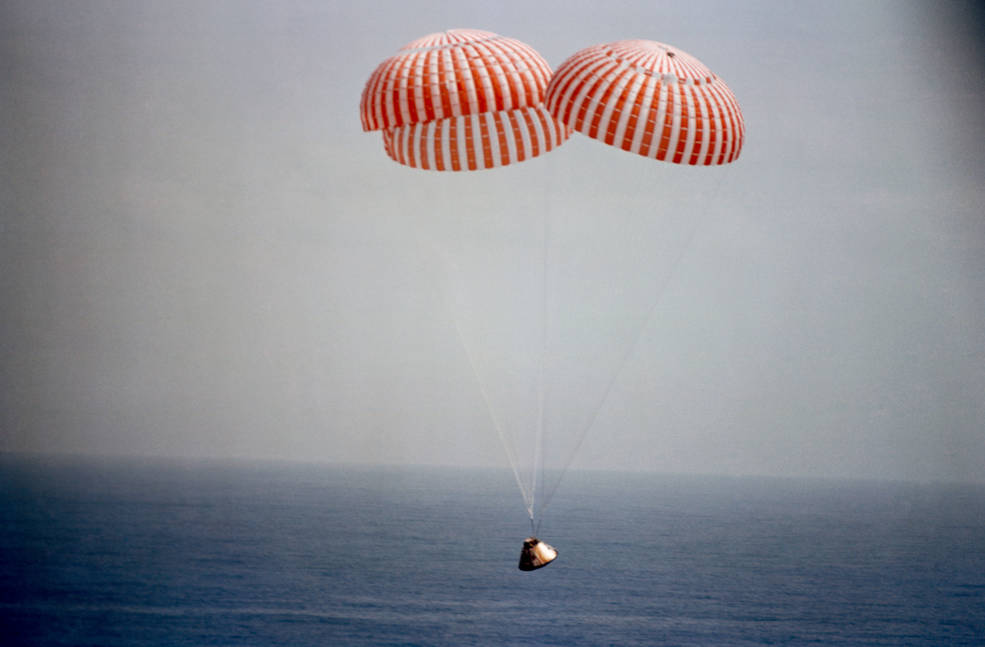
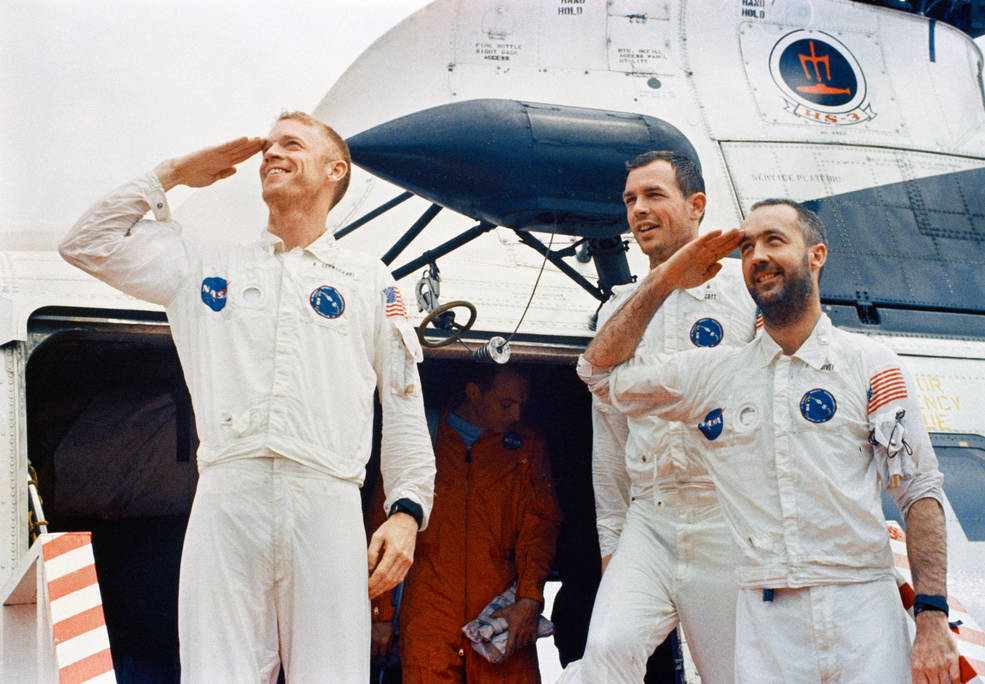
Left: The Apollo 9 CM under its three main parachutes, moments before splashdown.
Right: Apollo 9 crew of (left to right) Schweickart, Scott, and McDivitt exiting the recovery helicopter on board the USS Guadalcanal.
The splashdown point in the Atlantic Ocean was about 670 miles south-southwest of Bermuda, and about 3 miles from the prime recovery ship the USS Guadalcanal. Total mission duration since launch was 241 hours and 54 seconds. Forty-nine minutes after splashdown, the crew was aboard the recovery ship, and soon partaking of a 350-pound cake baked in their honor. The next day, a helicopter flew them to Eleuthera in the Bahamas, where they boarded a plane to the Kennedy Space Center for a brief ceremony, and then back to Houston for a large welcome home reception and a reunion with their families. Gumdrop was removed from the Guadalcanal in Norfolk, Virginia, and flown to Long Beach, California, then trucked to the North American Rockwell plant in Downey for postflight inspection. It is currently on display at the San Diego Air and Space Museum. The successful Apollo 9 mission, the most complex crewed space mission flown to that time, brought the Moon landing one step closer. The next step tested the LM in lunar orbit – while Apollo 9 was in orbit, NASA rolled out the Saturn V rocket for that mission, Apollo 10, planned to fly in May.
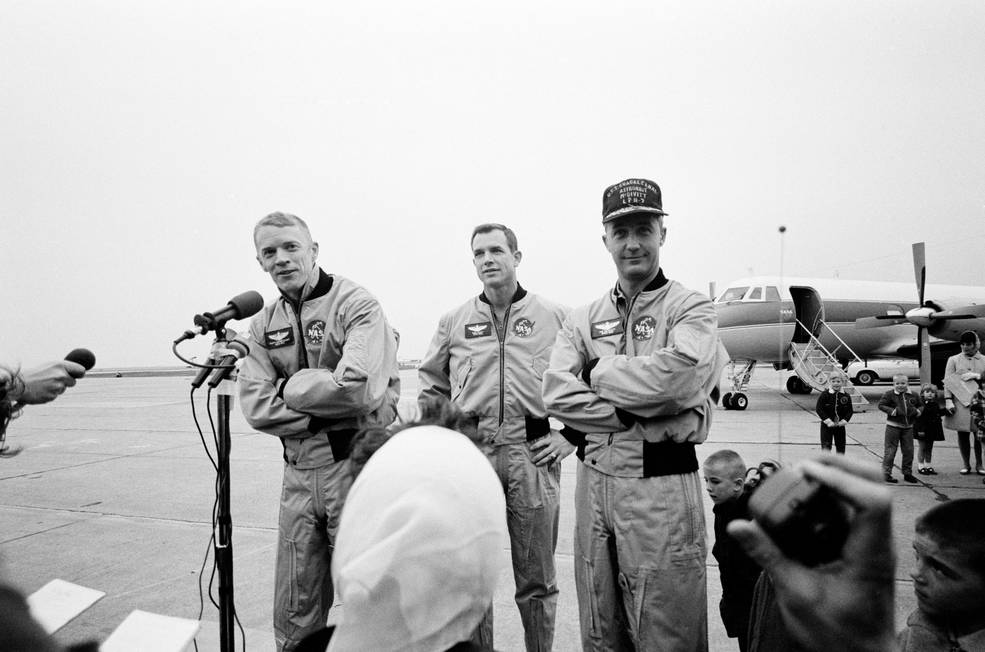
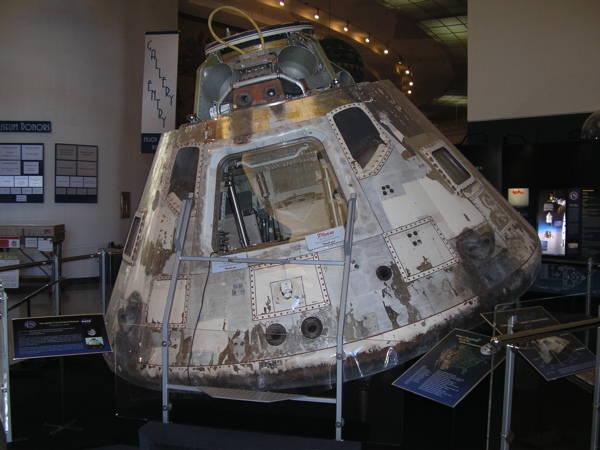
Left: Apollo 9 crew of (left to right) Schweickart, Scott, and McDivitt upon their return to Ellington Air
Force Base in Houston. Right: The Apollo 9 CM on display at the San Diego Air and Space Museum. Image courtesy of SDASM.
In conjunction with the Apollo 9 splashdown, NASA conducted a simulation of recovery operations of astronauts returning from a lunar mission. NASA Flight Surgeon Dr. William Carpentier, project engineer John Hirasaki, and three astronaut stand-ins, Paul Kruppenbarcher, Texas Ward, and Arthur Lizza, spent 10 days inside a Mobile Quarantine Facility (MQF), a modified Airstream trailer designed to temporarily house astronauts returning from the Moon. The three astronaut surrogates began the simulation by entering a mockup Command Module that was placed in the ocean and recovered as if returning from a space mission. The trio donned Biological Isolation Garments (BIG), meant to prevent contamination of Earth by any possible lunar organisms. Once on board the Guadalcanal, the three accompanied by Carpentier and Hirasaki entered the MQF for four days, where the just-recovered Apollo 9 crew visited them through the window of the trailer. The five stayed inside the MQF except for the short time it was transferred from the Guadalcanal to a waiting transport aircraft at Norfolk Naval Air Station and flown back to Houston. After offloading, the MQF and its five inhabitants were transferred to the Lunar Receiving Laboratory at MSC to begin a simulated quarantine. Overall the exercise proved the procedures for the activities that took place after the first lunar landing mission.
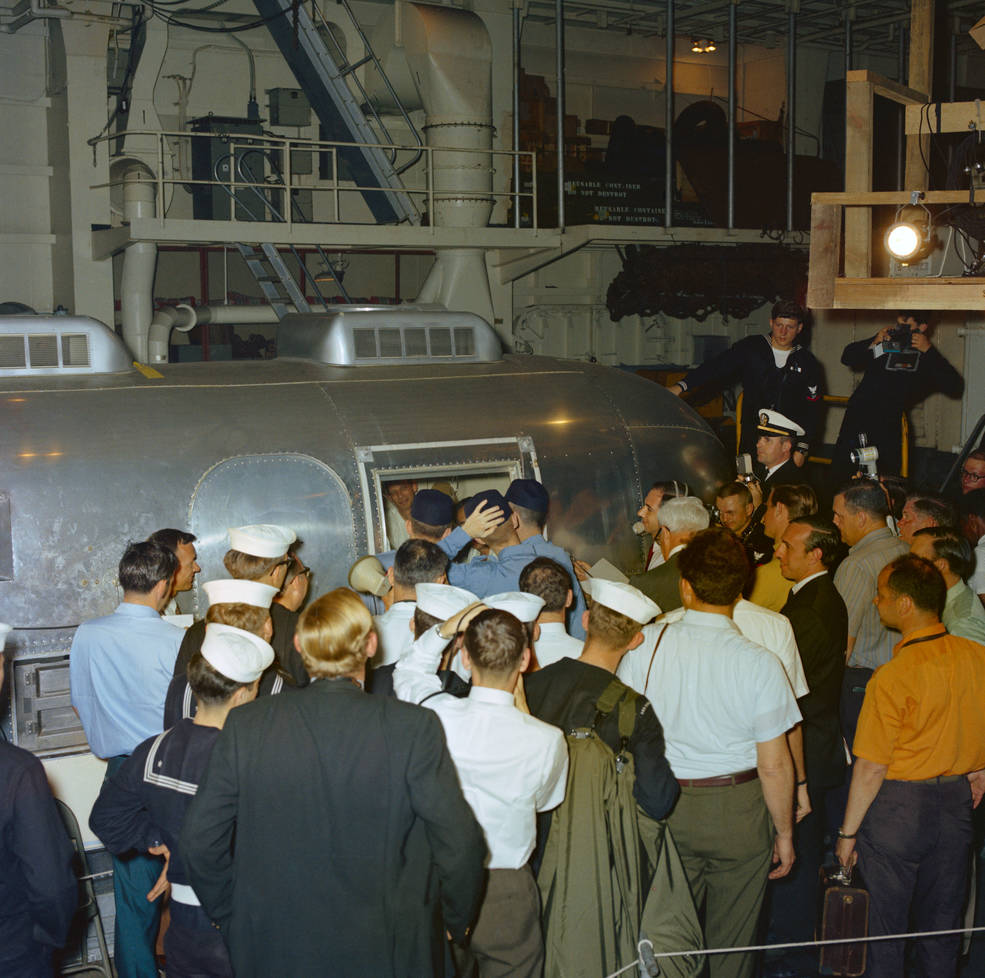
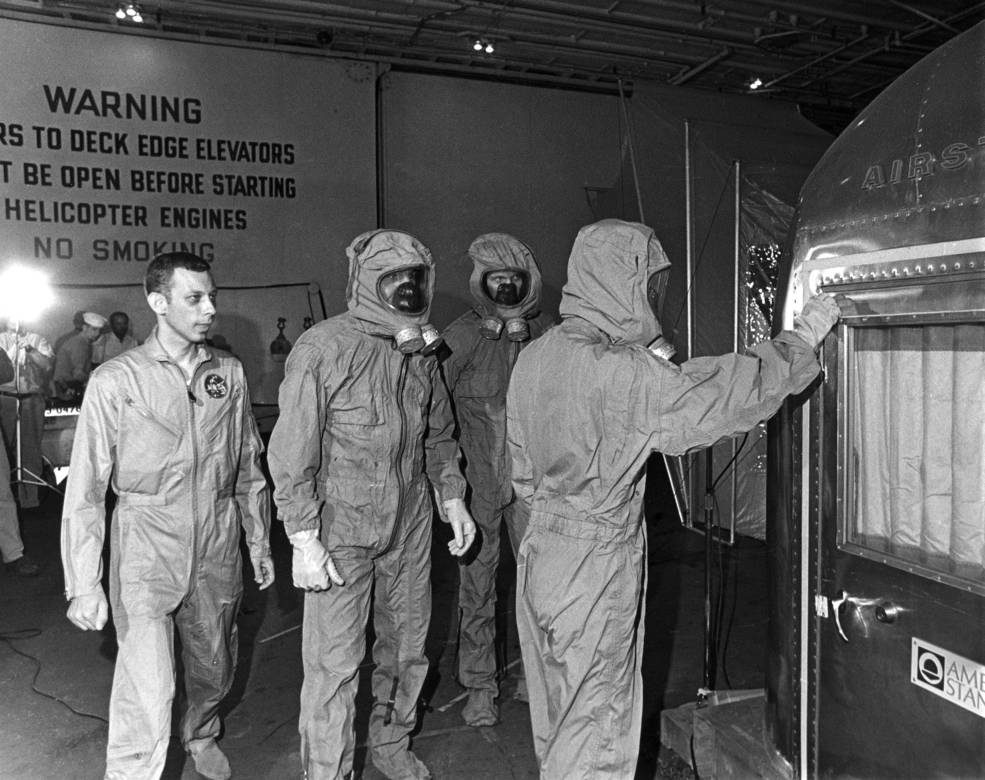
Left: Apollo 9 crewmembers (wearing blue baseball caps) peer in through the window of the Mobile Quarantine
Facility (MQF) aboard the USS Guadalcanal. Right: Flight surgeon Carpentier (left) and three astronaut stand-ins wearing
Biological Isolation Garments about to enter the MQF aboard the USS Guadalcanal.
Enjoy a video summary of the Apollo 9 mission at: https://www.youtube.com/watch?v=xytZh161E7o
Read McDivitt and Schweickart’s recollections of the Apollo 9 mission in their oral histories with the JSC History Office.


























